
長谷川 亘(はせがわ・わたる)
京都コンピュータ学院統括理事・京都情報大学院大学教授
米国コロンビア大学ティーチャーズカレッジ 教育学M.E.d
(社)京都府情報産業協会会長 全国地域情報産業団体連合会理事
Your Excellency Mr. Pero Matic, ambassador of Bosnia and Herzegovina,
Your Excellency Mr. Rysbek Moldogazieve, ambassador of the Kyrgyz Republic,
Your Excellency Mr. Gabriel John Klero Dusava, ambassador of Papua NewGuinea,
京都府副知事 山下 晃正様,京都市市長 門川 大作様,国内外の大学学長様をはじめとする教育機関,各法人や多くの企業の皆々様にご臨席賜りましたことを,厚く御礼申しあげます。
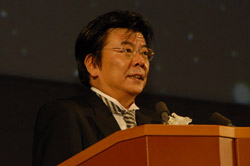
京都コンピュータ学院は本年,創立50周年の佳節を迎えました。また,京都情報大学院大学は,2003年の開学宣言と認可決定以来,ちょうど10年となります。
本日のこの佳き日を,ここにご参列いただきました卒業生・校友の皆様,在学生の皆様,ならびにライブ映像のストリーミング配信をご覧になっている校友や在学生の皆様とご一緒に迎えることは,教職員一同の大きな喜びです。
本学を代表して,僭越ながら式辞を述べさせていただきます。
京都コンピュータ学院の原点は,京都大学の卒業生である初代学院長・長谷川繁雄と現学院長・長谷川靖子が始めた私塾にあります。こちらが,創立者の一人,長谷川靖子でございます。(立礼&拍手)ありがとうございます。
お陰様で,まだまだお元気です。
本学は現在,京都コンピュータ学院洛北校,鴨川校,京都駅前校,京都日本語研修センター,そして,京都情報大学院大学の京都本校,札幌サテライト,東京サテライトと,人材会社である株式会社KCGキャリアをもって,小さいながらも京都に拠点を置くKCGグループを構成しております。また,ニューヨークと北京,そして大連には,国際交流のためのオフィスを設置しております。
1963年(昭和38年),今から50年前に,創立者夫妻が営んでいた中高校生対象の小さな私塾で,当時長谷川靖子が大学院生として所属していた,京都大学宇宙物理学教室や,他の専攻の若手研究者のための「FORTRAN研究会」を始めました。塾としての歴史は,もう少し遡り1957年の開設でしたが,私どもはこの研究会の開始年度を,本学の始まりとしております。
その当時コンピュータは,ごく一部の研究者だけのものでしたが,日を重ねるにつれ,その研究会は,近畿圏の企業関係にも広く伝わることとなります。
本日は堀場 雅夫様ご本人にご来臨賜っております。株式会社堀場製作所様における,最初期のコンピュータプログラムを作成したのは,長谷川靖子でした。そのご縁もあって堀場様には,京都情報大学院大学の設立発起人としてご参与いただいております。
1969年(昭和44年),人類が月面に降り立った年には,「京都コンピュータ学院」という校名を掲げて,高校卒業者を対象とする全日制課程が開設されました。そのとき,創立者・長谷川繁雄は「ソフトウェアとは,ものの考え方のことであって,哲学の一種であり,これは人類史を変革する」という言葉を残しております。
その後,1976年には新法制による専修学校認可をいただき,長谷川靖子の指導教授,京都大学理学部宇宙物理学教室の宮本正太郎先生が名誉学院長に就任されました。「学院長」という言葉には校長や学長という意味もありますが,本学では,校祖・学祖を意味し,「学院長」というポジションは,創立者夫妻と宮本先生の三名のみと定めております。
創立以来,本学は常にソフトウェア技術の学問的性格を重視し,単なる知識技術の伝授に終始することなく,理論を重視したコンピュータの教育を実践してまいりました。「時代を担う創造性豊かな情報処理技術者の育成」という教育理念は,時を経ても,変わることなく受け継がれており,本学の教育哲学の根幹をなしております。
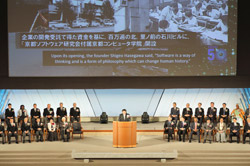
本学は,古くから関係の深い京都大学をはじめとし,アメリカのマサチューセッツ工科大学(MIT)やハーバード大学,ロチェスター工科大学(RIT),コロンビア大学など,海外の諸大学とも密接な関係を持ちながら,コンピュータ関係のみならず,各分野で先達に学びつつ,常に,教育理念を踏まえ,「学校としての情報教育の本質」を極めようと努力してまいりました。
1996年には,ロチェスター工科大学と姉妹校提携を行い,その二年後からITプロフェッショナル大学院教育の単位互換学科を,専門学校の課程として設置しました。
同じ頃,本学関係者が当時MITに在籍していたこともあり,本学は「.edu」のトップレベルドメインを取得しました。「.edu」は米国連邦政府が認証する高等教育機関のみに与えられるトップレベルドメインです。日本国内に本拠地を置く教育機関の中,「.edu」を取得できたのは本学のみでしたので,それを記念する意味もあり,本学の徽章は「kcg.edu」に制定されました。
今から10年前,大学認可をいただき,IT専門職分野における国内での最高学位を授与する,京都情報大学院大学を開学いたしました。長谷川繁雄初代学院長の時代を第一世代,靖子学院長の時代を第二世代としますと,この頃から徐々に本学は,第三世代に移っていきます。
京都情報大学院大学は,IT業界のリーダーとなるべき高度専門職業人を育成する,日本最初のIT専門職大学院として,高い評価をいただいております。京都コンピュータ学院と併修して,高校卒業後5年間で,修士号,プロフェッショナル・ディグリーですが,それを取得できるプログラムも設置しています。昨年4月に札幌,10月には東京に大学院のサテライトを開設し,京都からeラーニングでの授業を配信しています。
開学当初からアジア全域を対象とする,ITプロフェッショナルスクールを目指して,海外他国の大学との提携も進めてまいりました。中国では天津科技大学をはじめとする数多くの大学,韓国の高麗大学校情報保護大学院,チェコ共和国のオストラバ工科大学,パルドゥビッツェ大学など,世界の多くの大学と学術交流や姉妹校の協定を締結しております。海外の提携大学は,90校以上にのぼります。
海外の大学とは,第二代学長の頃から,インターネットを介しての,合同授業の実験なども進めてきました。今では,各大学から多くの留学生が本学で学び修了しています。
本学と海外諸国との良きお付き合いは,外務省ならびにJICA様(独立行政法人国際協力機構様)のご指導ご協力のもと,継続的に発展しております。本学は,1989年から,発展途上国支援を開始し,当該国政府と合弁して,パソコンの大量寄贈と教員指導,カリキュラム設計などを行ってきました。その対象国は23か国にのぼります。
本日は大使閣下にご来臨賜っておりますが,近年ではボスニア・ヘルツェゴビナやキルギス共和国,パプアニューギニア独立国に対しパソコンを寄贈いたしました。寄贈したパソコンは各大学でコンピュータ教育に活用されています。パプアニューギニア独立国のゴロカ大学には,コンピュータ室「KCG Lab」が開設されました。
また,ハイブリッドやEV,自動車のIT化に即応すべく,2005年に日本初の「自動車制御学科」を開設しました。自動車はもはやコンピュータが制御するロボットであり,完全に自律して人を目的地に連れて行ってくれるレベルまで来ています。
2009年,情報処理学会より「分散コンピュータ博物館」第一号の認定をいただき,以来,本学が保存するコンピュータのうち5機種が情報処理技術遺産に指定されております。本学創立者が標榜したように,ソフトウェアはハードウェアという実体を伴い,「人類史を変革」し続けています。
自動車や電気製品のみならず,日本が世界に誇るマンガやアニメも現在急速にIT化が進んでいます。そのため,各専門分野から実務系教授を招へいし,大学院にはコンテンツビジネスコースを設置いたしました。
KYOTO Cross Media Experience(KYOTO CMEX)の実行委員や,京都国際マンガ・アニメフェアの実行委員なども仰せつかっております。京都がコンテンツ産業やクールジャパンの中心になるように,一翼を担わせていただきたいと考えております。
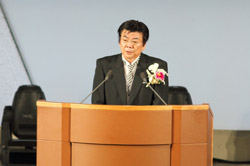
そして,本学は今年,インターネットの「.kyoto(ドット京都)」というトップレベルドメインの管理事業主体となります。京都府様,京都市様,京都商工会議所様,京都府警察本部様などのご協力・ご後援をいただきながら,50年前のFORTRAN研究会のように,まずは,「セミナーの開催」から始めます。産官学合同のオール京都で,ドット京都を創出することを実現させて,京都府の社会経済の発展に寄与することを願っております。トップレベルドメイン・ドット京都はフィジカル世界,つまり,「現実世界」の京都と,「サイバー世界」の京都を結びつける基盤となります。
こちらのCGは立命館大学地理学教室からお借りしたものですが,京都大学の石田亨先生の「デジタルシティ京都」など,サイバー世界に街を創ることに関しては,多くの先行研究があります。インターネットのアドレスに「.kyoto」を使うことは,まさにサイバー世界に京都府を創る,ということでもあります。それら先行研究の成果を投入するだけで,フィジカル世界の京都のブランド力を,サイバー世界に拡張することとなると共に,同時に,インターネットにおける,京都の情報発信能力が飛躍的に向上します。大学や企業・商店,府民・個人の皆さんも,新しい価値の創造が可能となり,京都の繁栄が期待されます。
千年の都,京都の街に育まれた京都コンピュータ学院は,京都情報大学院大学を生み出しました。そして,京都情報大学院大学は今,サイバー世界の中に,無限に広がる京都府を創り出そうと,生み出そうと,しています。半世紀の歴史を経て本学は,50年前のパイオニアスピリットにリンクしながら,トップレベルドメイン,ドット京都の付加価値についても,より多くの皆様にご理解いただけますように,活動を展開して参る所存です。ドット京都には,大きな夢と希望があります。
50年という歴史の中で,私どもは,多くの方々の温かいご支援をいただいてまいりました。本学のこれまでの実績を継承しつつ,今後も新たなチャレンジに邁進して参ります。
最後になりましたが,本日ご臨席の皆様,ご関係の皆様に,心から御礼申しあげるとともに,今後とも変わらぬご支援ご協力と,ご指導ご鞭撻を賜わりますよう,教職員一同,お願い申しあげます。
本日は,お忙しい中,ご来臨賜り,本当にありがとうございました。
英訳
The 50th Anniversary of Kyoto Computer Gakuin
The 10th Anniversary of The Kyoto College of Graduate Studies for Informatics
Welcome Address
Wataru Hasegawa, President/Chair of the Board
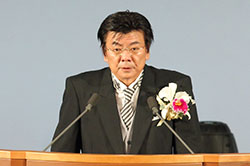
Your Excellency Mr. Pero Matic, the Ambassador of Bosnia and Herzegovina, Your Excellency Mr. Rysbek Moldogaziev, the Ambassador of Kyrgyz Republic, Your Excellency Mr. Gabriel John Klero Dusava, the Ambassador of Papua New Guinea, Mr. Akimasa Yamashita, the vice-governor of Kyoto Prefecture, Mr. Daisaku Kadokawa, the mayor of City of Kyoto, esteemed representatives of educational institutions including national and international universities, esteemed representatives of corporations and businesses, our alumni and students, I express my sincere gratitude for your presence today.
Kyoto Computer Gakuin (KCG) has marked its 50th anniversary this year. The Kyoto College of Graduate Studies for Informatics (KCGI) has marked its 10th anniversary from the time we were granted a university status and we declared launching of a new graduate school in 2003.
All of our faculty, staff members and students are deeply honored and pleased to commemorate this auspicious day together with our alumni here, including those who are participating through a streaming network facility.
Presently, please, on behalf of all the faculty and staff members at KCG Group, allow me to deliver a welcome address.
The origin of KCG is a private learning center which was opened by the first president of KCG Shigeo Hasegawa and the incumbent president Yasuko Hasegawa, who are both graduates of Kyoto University.
Currently, the KCG Group has Kyoto Computer Gakuin Kyoto Eki-mae Campus, Rakuhoku Campus, Kamogawa Campus, the Kyoto Japanese Language Training Center, the Kyoto College of Graduate Studies for Informatics with its satellite campuses in Sapporo and Tokyo, a staffing agency KCG Career and so on. Though small in scale, we have established the “KCG Group” solidly based in Kyoto. In addition, we also have set up offices for international operations, in New York, Beijing and Dailian.
At the small private learning center opened 50 years ago by the Hasegawas for junior high school and high school students, they launched “FORTRAN Workshop” in 1963. This was not only for young researchers of the Department of Astrophysics at Kyoto University, which Yasuko Hasegawa belonged to as a graduate student, but also for those who were majoring in other fields. Although the private learning center was originally started in 1957 well before 1963, the year of the establishment of “FORTRAN Workshop” was declared to be the foundation of the KCG school system.
The computer was only used by a small number of academic researchers around that time, but as time goes by, this workshop became also widely known to the industry sector in the Kinki region.
The first computer program for HORIBA, Ltd. was the one that the current president Yasuko Hasegawa produced. As a consequence, Mr. Masao Horiba, who is present here today, was kind enough to take part in the establishment of the Kyoto College of Graduate Studies for Informatics.
In 1969 when mankind first landed on the moon, we started offering full-time courses for high school graduates under the name of “Kyoto Computer Gakuin.” Upon its opening, the founder Shigeo Hasegawa said, “’Software’ is a way of thinking and is a form of philosophy which can change human history.”
Later in 1976, we were licensed as a higher education institution under the then newly established legislation, and then Professor Shotaro Miyamoto of the Department of Astrophysics, Faculty of Science, Kyoto University, became the honorary president of KCG. Professor Miyamoto used to be the academic advisor of Yasuko Hasegawa. Although the Japanese word “Gakuincho” means a school principal, we take its meaning as “founding father” in our school, and the founders Hasegawas and Professor Miyamoto are the only people who have been granted the title of “Gakuincho.”
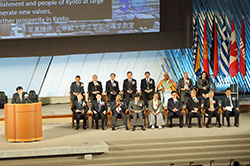
Since its foundation, our school has long been a practitioner of computer education valuing academic aspects of software technologies and emphasizing the theories to go beyond just teaching technical knowledge and skills. Our motto, “Nurturing IT specialists rich in creativity for future generations.,” has been passed on to this day and formed the basis of the educational philosophy of our school.
Learning from seniors not only in computer field but also various other fields based on our educational philosophy, we have been striving to pursue “the essence of information education as a school” in coordination with Kyoto University, which we have nurtured long-term relationship with, and various foreign universities: Massachusetts Institute of Technology (MIT), Harvard University, Rochester Institute of Technology (RIT), Columbia University and others.
In 1996, we established a sister school relationship with Rochester Institute of Technology, and two years later, launched a graduate-level credit transfer program in the IT field.
Around the same time, one of our faculty members, who was enrolled at MIT, made an arrangement for our school to obtain the top level Internet domain “.edu.” “.edu” is the top level domain which only the higher education institutions approved by U.S federal government can obtain. Of all Japan-based educational institutes around that time, our school was the only one that could use “.edu.” To emphasize its significance, we adopted the name “kcg.edu” as our school emblem.
Ten years ago, we were granted a university status and founded the new group school, the Kyoto College of Graduate Studies for Informatics (KCGI). This graduate school was to confer the highest academic degree for information technology professionals in the nation. The two periods when our school was run by the first president Shigeo Hasegawa and successively by the next president Yasuko Hasegawa could be considered the first and second generations of our school system, successively. We moved gradually into the third generation KCG Group by the time of the establishment of KCGI.
KCGI has been highly acclaimed as the first IT professional graduate school in Japan that fosters highly specialized professionals who are to take a strong leadership role in the IT field. We have also set up the collaborative program offered by KCG and KCGI, which allows high school graduates to complete their master’s (professional) degrees in five years. In addition, we opened KCGI satellite campuses in Sapporo in April and in Tokyo in October last year. Many of classes at these campuses are delivered through our e-learning facility from Kyoto.
Since its foundation, KCGI has promoted cooperation with foreign universities aiming to be an IT professional graduate school for Asia. We have established partnership and cooperative relations with over 90 overseas universities, including Tianjin University of Science and Technology of China, Korea University Graduate School of Information Security, VSB-Technical University of Ostrava and the University of Pardubice in Czech Republic, and others.
From the time of the second KCGI president, we have developed experimental joint classes via the Internet in collaboration with overseas universities. We host a large number of international students from these universities, many of whom have completed their education.
We have been developing friendly relationships with other countries in the world largely with the supports of the Ministry of Foreign Affairs and JICA (Japan International Cooperation Agency). In 1989, we became involved in assisting computer education in developing countries in collaboration with their governments. For instance, we have donated a large number of personal computers to some of the developing countries, organizing training courses for teachers and developing educational curriculums. We have provided such assistance to as many as 23 countries to this date.
In recent years, we have donated personal computers to Bosnia and Herzegovina, Kyrgyz Republic and Papua New Guinea, and we are graced with the presence of their Excellencies, the Ambassadors of Bosnia and Herzegovina, Kyrgyz Republic and Papua New Guinea today. In these countries, the donated computers are being used for computer education at universities. A computer lab named “KCG Lab” has been set up in the University of Goroka in Papua New Guinea.
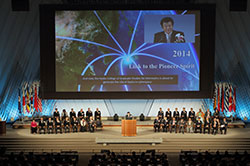
We set up Japan’s first Auto Control Engineering Department in 2005. This is in order to meet the growing IT needs of the auto industry, as typified by the appearance of hybrid and electric vehicles. It is not an exaggeration to say that automobiles are computer-controlled robots with a capacity of taking us to destinations completely autonomously.
In 2009, our school was designated as the first of the “Distributed Museum of the Historical Computers” by the Information Processing Society of Japan, and of all the computer systems retained by us, five systems have been designated as Information Processing Technology Heritages. As called for by the founder of our school, software, coupled with hardware, has indeed changed and is changing human history.
In addition to automobiles and electronic products, use of IT in the fields of world-famous manga and anime has been progressing rapidly. In response to this trend, we have invited authorities in related fields to join our faculty, and set up the Content Business program in the graduate school.
I have been appointed an executive committee member of the KYOTO Cross Media Experience (KYOTO CMEX) and the Kyoto International Manga Anime Fair. For Kyoto to become the center of the content business and the “Cool Japan” movement in this country, we would be much honored to play a part.
This year, we will become the organization responsible for management of the top level Internet domain “.kyoto” (pronounced “dot kyoto”). With the cooperation and backing of Kyoto Prefecture, Kyoto City, the Kyoto Chamber of Commerce and Industry and Kyoto Prefectural Police Headquarters, we will organize a series of seminars to promote its use, much like the “FORTRAN Workshop” of fifty years ago. Based on the joint efforts of industry-government-academia collaboration, we are hoping to create the new entity “.kyoto” that can bring about revolutionary socioeconomic developments in Kyoto. The top level domain “.kyoto” provides a platform for binding the physical Kyoto (Kyoto in the real world in other words) and “kyoto” in cyberspace.
This computer graphics image was borrowed from the Department of Geography at Ritsumeikan University. There have been many pioneering projects on cyber city Kyoto, including “Digital City Kyoto” developed by Professor Toru Ishida of Kyoto University. Making use of “.kyoto” in Internet addresses is the equivalent of producing Kyoto Prefecture in the cyber world. Just by devoting the resources acquired from the preceding studies, we can extend the Kyoto brand to cyberspace, and also the information transmission capability of Kyoto improves spectacularly at the same time. That means universities, business establishment, people of Kyoto and all individuals at large should be able to generate new values, which will be linked with further prosperity in Kyoto.
Nurtured in the millennial city, Kyoto, Kyoto Computer Gakuin has produced the Kyoto College of Graduate Studies for Informatics. And now, the Kyoto College of Graduate Studies for Informatics is about to generate Kyoto Prefecture with infinite possibilities in cyber world. After 50 years since our establishment, we will now, linking to the pioneer spirit from 50 years ago, strive to serve to win the understanding and acceptance of more and more people about the value and possibilities of “.kyoto.”
“.kyoto” is a spring of full hopes and dreams.
Throughout our 50-year history, we have received warm support from a great number of people. Inheriting KCG’s historical achievements in the past fifty years, we are determined never to stop challenging new possibilities.
On behalf of all the faculty and staff of KCG Group, I would like to conclude by saying “thank you”, from the bottom of my heart, to all of you here today and all who have supported us to this day. I shall greatly be indebted if you could extend us the same warm support and encouragement as you have given us in the last 50 years.
I thank you very much again for taking time out of your busy schedule to be part of this ceremony.
動画
統括理事長 長谷川 亘 式辞 KCGグループ創立50周年記念式典
Welcome Address by President of KCG Group Wataru Hasegawa (Live)
統括理事長 長谷川 亘 式辞 KCGグループ創立50周年記念式典
Welcome Address by President of KCG Group Wataru Hasegawa

